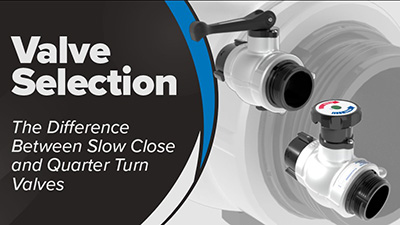Valve Selection: Slow Close vs Quarter Turn Valve
As you assess firefighting equipment for your fire station you will likely see mention of quarter turn and slow close valves. These valve control styles might be options on hydrant valves, intake valves, or other appliances you evaluate.
You might be wondering what the difference between the two is and which one is right for you.
In this article, we will look at each valve style and compare them to highlight the similarities and differences.
What is a Quarter Turn Valve?
 |
|
A quarter turn valve works exactly as it sounds. Typically, a lever style handle controls the valve. You need to turn it a quarter turn to fully open or close your valve.
Some manufacturers build their quarter turn valves with a foldable handle that allows you to adjust your handle’s position for safety or convenience purposes. For example, if you are trying to make a hose connection but your valve handle is in the way, you can flip the handle upright to free up space. Once your hose is connected you can then return the handle to its normal position. This feature can also increase safety as you can move the valve handle to avoid accidental bumps that can cause unintended opening or closing.
What is a Slow Close Valve?
 |
A slow close valve operates by use of a circular knob with clearly marked positions on it. With this valve style you can easily open and close your valve by turning the knob continuously in one direction.
An added benefit of this valve is that the knob takes up a small amount of space and is harder to accidentally bump or move. This is a safety benefit that can limit accidental bumps that may cause water hammer or other issues.
How are Slow Close and Quarter Turn Valves Similar?
The two valves share many similarities:
Flow Control
Both slow close and quarter turn valves are acceptable ways to control the flow of water through an appliance. They can be gated to dial in the water supply based on your needs. Either valve style will get the job done. Both valve styles are also created to avoid slamming shut under pressure.
NFPA (National Fire Protection Association) Requirements
Both valve styles should meet NFPA 1964 recommendations. This includes their recommendations on valve timing and how much force is needed to open and close the valve. Neither valve is difficult to operate, even under pressure.
Clear Open and Close Indicators
The valve style you choose should always have clear indicators for open and closed positions. The slow close and quarter turn valve styles are no different. Slow Close valves typically have a sticker or other indicator on the top side of the valve control knob. Quarter turn valves may rely on NFPA position requirements or may have visual indicators available. Industry standard is the handle being in line with the valve body when open and perpendicular to the valve body when closed.
 |
A slow close valve's open and closed positions are easily determined with visual indicators on the slow close handle. |
How do Slow Close and Quarter Turn Valves Differ?
Handle Style
These valves have different handle styles that let you control the valve. Quarter turn valves include a handle that is easy to grip and turn. The handle must be kept in mind to avoid accidental bumps or movement that can lead to water hammer and unintended valve movement. An easy way to address this is by choosing an appliance with a folding handle option. These handles can be folded or flipped out of the way when needed.
Slow close valves use a knob that turns much like your radio’s volume control dial. These knobs are still very easy to turn and have the added benefit of controlling the speed of opening or closing due to the rotation needed to work the valve. They are also more difficult to accidentally bump out of position.
Level of Control
While each valve style allows you to open and close the valve easily, the slow close valve gives you more control over your water supply. The knob style valve allows you to gate the valve into specific positions, fine tuning as you turn. The quarter turn valve is not as precise but does still allow you to gate the valve.
Which Valve Style is Right for You?
Choosing a valve style often comes down to department preference. As you evaluate your options, you should consider safety and the style of valve your crew is accustomed to using. Remember, both valve styles will do what you need them to, but you may prefer a certain style based on your own department’s needs.
